Ellen Geer updates Henrik Ibsen’s An Enemy Of The People to 1980 and Americanizes it to South Fork, South Carolina in a problematic World Premiere adaptation that would probably work better if its Theatricum Botanicum cast didn’t have a week off between each performance.
A prologue not in Ibsen’s original starts things off with a gut punch as Ku Klux Klan leader David Duke (Matthew Pardue) spouts racist bile to a crowd of adoring fellow Klansfolk amidst shouts of “White power!” not unlike cries of “Send her back!” heard only a few weeks ago.
 Cut to the home of Dr. Tom Stockman (Christopher W. Jones), his African-American wife Katherine (Earnestine Phillips), Katherine’s schoolteacher daughter Patience (Constance Jewell Lopez), and the couple’s biracial tweens Tyrone (Joseph Iwunze) and Joey (Joelle Lewis), joined this evening by Horatio (Max Lawrence), editor of the town’s liberal newspaper The People’s Voice, assistant editor Gerald (Terrence Wayne, Jr.), both black, and Patience’s cruise-ship-captain boyfriend Billings (Steven C. Fisher), white.
Cut to the home of Dr. Tom Stockman (Christopher W. Jones), his African-American wife Katherine (Earnestine Phillips), Katherine’s schoolteacher daughter Patience (Constance Jewell Lopez), and the couple’s biracial tweens Tyrone (Joseph Iwunze) and Joey (Joelle Lewis), joined this evening by Horatio (Max Lawrence), editor of the town’s liberal newspaper The People’s Voice, assistant editor Gerald (Terrence Wayne, Jr.), both black, and Patience’s cruise-ship-captain boyfriend Billings (Steven C. Fisher), white.
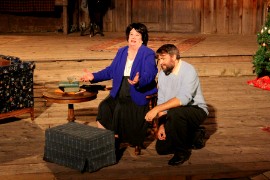 Less welcome at tonight’s family gathering is unexpected visitor Mildred Stockman (Katherine Griffith), Tom’s Big Daddy-esque town mayor sister, here to inquire about an article soon to appear in The People’s Voice.
Less welcome at tonight’s family gathering is unexpected visitor Mildred Stockman (Katherine Griffith), Tom’s Big Daddy-esque town mayor sister, here to inquire about an article soon to appear in The People’s Voice.
What Mildred has heard tell is that Tom, chief medical officer of the town’s Healing Waters Spa (or Healing Springs depending on who you ask), has uncovered proof that the waters of said spa/spring are polluted with “contaminants, bacterial pathogens, coli strains, shigellosis, salmonellosis…you name it…we got it,” news the younger Stockman expects his sister to welcome as an opportunity to fix the problem before it gets even worse.
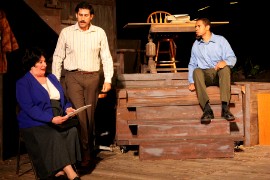 Mildred, the spa’s CEO Chairman of the Board, sees things in quite a different light, particularly when informed that the cleanup will take two years, cost a million dollars ($3,000,000 adjusted for inflation), and put countless citizens out of work, the spa/spring being South Fork’s biggest moneymaker.
Mildred, the spa’s CEO Chairman of the Board, sees things in quite a different light, particularly when informed that the cleanup will take two years, cost a million dollars ($3,000,000 adjusted for inflation), and put countless citizens out of work, the spa/spring being South Fork’s biggest moneymaker.
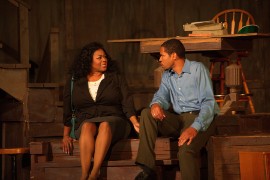 Anyone who assumes that Ibsen adapter Geer (who co-directs with Melora Marshall) has concocted this hot-button-issue plot device on her own hasn’t read the prescient Norwegian playwright’s late-19th-century original.
Anyone who assumes that Ibsen adapter Geer (who co-directs with Melora Marshall) has concocted this hot-button-issue plot device on her own hasn’t read the prescient Norwegian playwright’s late-19th-century original.
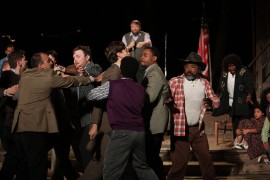 Factor in white supremacists and you’ve got a contemporary adaptation whose first act proves more successful than a second act with rather a bit too much on its plate once issues of race are added to the already volatile environment-vs.-economy debate.
Factor in white supremacists and you’ve got a contemporary adaptation whose first act proves more successful than a second act with rather a bit too much on its plate once issues of race are added to the already volatile environment-vs.-economy debate.
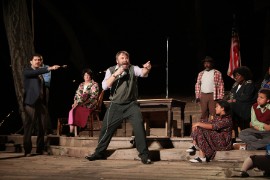 Sticking close to Ibsen’s original script leaves too many unanswered questions about Tom, Katherine, and their children’s lives in racist South Carolina. A key decision made by Horatio makes considerably less sense coming from the African-American editor of a progressive newspaper than it probably did in 1880s Norway. And while most of the adaptation’s first act sounds as if it could have been written this year, Tom’s sermonizing at an over-the-top town hall meeting (not to mention lines like “All who live by lies ought to be exterminated like vermin!” coming straight from Ibsen) feels a century old both in substance and style.
Sticking close to Ibsen’s original script leaves too many unanswered questions about Tom, Katherine, and their children’s lives in racist South Carolina. A key decision made by Horatio makes considerably less sense coming from the African-American editor of a progressive newspaper than it probably did in 1880s Norway. And while most of the adaptation’s first act sounds as if it could have been written this year, Tom’s sermonizing at an over-the-top town hall meeting (not to mention lines like “All who live by lies ought to be exterminated like vermin!” coming straight from Ibsen) feels a century old both in substance and style.
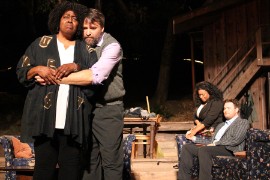 Equally troublesome are performances that could well be quite wonderful if cast members were uniformly on top of their lines and not stumbling over them as might be expected during a rehearsal or preview but not six weeks after opening night, presumably the result of too much time off between shows.
Equally troublesome are performances that could well be quite wonderful if cast members were uniformly on top of their lines and not stumbling over them as might be expected during a rehearsal or preview but not six weeks after opening night, presumably the result of too much time off between shows.
In the plus column, Beth Eslick’s costumes capture the look of a new decade just getting started, Zachary Moore’s evocative lighting makes an evening performance preferable to a matinee, Sydney Russell’s properties merit their own kudos as well, and sound designer Veleriya Nedviga inserts requisited effects and some nostalgic disco-era tunes along the way.
Gerald Rivers’ Cornell and Jeff Wiesen’s Alan complete the principal players, with a dozen Theatricum Botanicum interns doing background work as racist townsfolk.
Sarahjeen Francois is assistant director. Elna Kordijan is stage manager and Caitlyn Ryan is assistant stage manager.
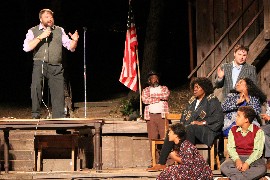 Had Theatricum Botanicum simply revived Ibsen as written, audiences would have marveled at the play’s contemporary relevance. Had Ellen Geer been inspired by the 1882 original to write something brand new, the result would have been more rewarding. If the cast were performing several times a week, their work would have the razor-sharpness expected from a professional production. As is, An Enemy Of The People disappoints more often than it satisfies.
Had Theatricum Botanicum simply revived Ibsen as written, audiences would have marveled at the play’s contemporary relevance. Had Ellen Geer been inspired by the 1882 original to write something brand new, the result would have been more rewarding. If the cast were performing several times a week, their work would have the razor-sharpness expected from a professional production. As is, An Enemy Of The People disappoints more often than it satisfies.
The Will Geer Theatricum Botanicum, 1419 N. Topanga Canyon Blvd., Topanga.
www.theatricum.com
–Steven Stanley
August 4, 2019
Photos: Kim Cameron, Kevin Hudnell
Tags: Henrik Ibsen, Los Angeles Theater Review, Theatricum Botanicum



 Since 2007, Steven Stanley's StageSceneLA.com has spotlighted the best in Southern California theater via reviews, interviews, and its annual StageSceneLA Scenies.
Since 2007, Steven Stanley's StageSceneLA.com has spotlighted the best in Southern California theater via reviews, interviews, and its annual StageSceneLA Scenies.







 COPYRIGHT 2025 STEVEN STANLEY :: DESIGN BY
COPYRIGHT 2025 STEVEN STANLEY :: DESIGN BY